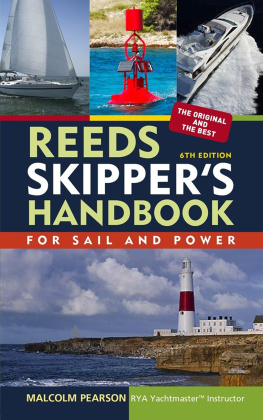

Contents
You are about to embark on a great adventure, following in the steps of great and famous seafarers Horatio Nelson, Robin Knox-Johnson and Ellen MacArthur, to name but a few. I suspect they all started where you are about to begin learning seamanship, pilotage and navigation from a book before putting it all into practice on the water and taking charge of a boat for the first time.
Their first voyage in a small boat would have been a short passage in sheltered water in daylight exactly what is expected of a student participating in a Royal Yachting Association Day Skipper course at a practical teaching centre.
RYA theory courses are for both powerboaters and yachtsmen and form part of the YachtmasterTM training scheme, which is internationally respected and the envy of the world.
This book covers all the subjects in the Day Skipper theory course syllabus and a lot more besides. Questions have been included at the end of each chapter so that you can practise your new skills, and I hope that I have achieved a balance between traditional methods and the use of electronic equipment that was not available to many of us when we skippered for the first time. Good luck and happy learning.
Alison Noice
April 2013


* Syllabus is the same for sailing and motor cruising
** Different courses for tidal and non-tidal waters
This theory course provides a comprehensive introduction to Navigation, Pilotage, Chartwork, Meteorology and the International Regulations for Preventing Collisions at Sea. It provides the necessary background knowledge for students prior to commencing the Day Skipper Practical course and enables them to get full benefit from that course. The RYA Shorebased Day Skipper course is also an ideal refresher for those about to start a Coastal Skipper and YachtmasterTM Shorebased course, which contains many of the subjects, taught on the Day Skipper Shorebased course, but to a greater depth of knowledge.
Nautical terms Parts of a boat and hull General nautical terminology.
Ropework Knowledge of the properties of synthetic ropes in common use.
Anchorwork Characteristics of different types of anchor Considerations to be taken into account when anchoring.
Safety Knowledge of the safety equipment to be carried, its stowage and use Fire precautions and fire fighting Use of personal safety equipment, harnesses and lifejackets Ability to send a distress signal by VHF radiotelephone Basic knowledge of rescue procedures including helicopter rescue.
International Regulations for Preventing Collisions at Sea Steering and Sailing Rules 5, 7, 8, 9, 10 and 1219 (Full knowledge) All other rules (outline knowledge).
Definition of position, course and speed Latitude and longitude Knowledge of standard navigational terms True bearings and courses The knot.
Navigational charts and publications Information shown on charts, chart symbols, representation of direction and distance Navigational publications in common use Chart correction.
Navigational drawing instruments Use of parallel rulers, dividers and proprietary plotting instruments.
Compass Application of variation Awareness of deviation and its causes Use of hand-bearing compass.
Chartwork Dead reckoning and estimated position including an awareness of leeway Techniques of visual fixing Satellite-derived positions Use of waypoints to fix position (full knowledge) Course to steer.
Tides and tidal streams Tide definitions, levels and datum Tide tables Use of Admiralty method of determining tidal height at standard port and awareness of corrections for secondary ports Use of tidal diamonds and tidal stream atlases for chartwork.
Visual aids to navigation Lighthouses and beacons, light characteristics.
Meteorology Sources of broadcast meteorological information Knowledge of the terms used in shipping forecasts, including the Beaufort scale and their significance to small craft Basic knowledge of highs, lows and fronts.
Passage planning Preparation of navigational plan for short coastal passages Meteorological considerations in planning short coastal passages Use of waypoints on passage Importance of confirmation of position by an independent source (full knowledge) Keeping a navigational record (full knowledge).
Navigation in restricted visibility Precautions to be taken in, and limitations imposed by, fog.
Pilotage Use of transits, leading lines and clearing lines IALA system of buoyage for Region A Use of sailing directions Pilotage plans and harbour entry.
Marine environment Responsibility for avoiding pollution and protecting the marine environment.
Enthusiasts who decide to take to the water will probably have first visited a boat show and enjoyed its gloss and hype or wandered down to the harbour when on holiday and chatted to the owners of boats secured to the quay. Either way they quickly realise that boats come in all shapes and sizes, are powered by different means, and that the sea has a language of its own!
This chapter doesnt aim to replace the nautical dictionary this quick introduction will give the basics while the rest of the book, and some time on the water, will fill in the gaps. To begin with, you need enough knowledge to know what to look for at the yacht broker, or when you embark on your first cruising course.
Nautical Terms
Directions
All boats, whether powered by engine or sail, are affected by the wind. Motor cruisers often have high superstructure supporting the upper steering position and are liable to be affected by the wind, particularly when manoeuvring at slow speed. Sailing yachts use the wind to drive them forward but are also pushed sideways making leeway when heeled over by the wind.
The upwind side of the boat is called the windward side and the sheltered side is the leeward side (pronounced loo-erd).
The widest part of the boat is called the beam, so an object sighted at right-angles to the boat on the right-hand side would be described as being on the starboard beam.
When looking ahead, the left-hand side of the boat is the port side and shows that side shaded red the colour of the port navigation light. A quick memory jogger is to remember that port wine is red.

FIG 1.1 An object seen behind the boat is described as being astern or aft.

Next page


















